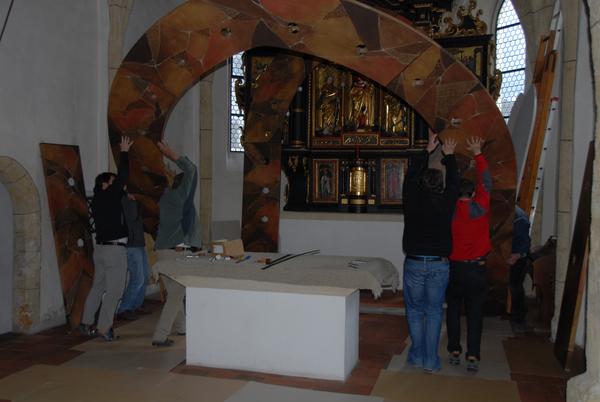Pfunds Brotherhood of the Holy Grave
Social practices in Tyrol, inscribed 2013
Founded in 1511, the Brotherhood of the Holy Grave (Heiliggrab-Bruderschaft) in Pfunds, Tyrol, has devoted itself to maintaining the tradition of erecting the Holy Grave on the Saturday before Palm Sunday and the 24-hour, uninterrupted worship of the Blessed Sacrament from Good Friday to Holy Saturday. The Brotherhood has always existed independently of the Catholic Church and the respective municipal government. At the same time, it addresses the entire community, including women and young people in these traditions as well.
The tradition of the Holy Graves can be traced back to Christ’s tomb in Jerusalem, which was discovered in the year 326 under Emperor Constantine and marked through the erection of a majestic church. The influence of the pilgrimages to the Holy Land and the Crusades led to the dissemination of replicas throughout all of Europe. Each year in the Gothic Liebfrauen Church in Pfunds, one of the 12 groups, each consisting of 16 men, is responsible for the erection and dismantling of the Holy Grave. This honourable as well as demanding task—three stage backdrops, growing narrower front to back, must be assembled, secured, and decorated with glass balls filled with coloured liquid for the oil lamps—is assumed by one of the prayer groups every 12 years according to a rotation system. The respective prayer group is also responsible for other tasks, such as carrying the baldachin, the lanterns, and the flag of the Brotherhood in the ceremonious procession. All members of the Brotherhood take turns being present in the church from Good Friday at 3 p.m. to Holy Saturday at 3 p.m. in order to ensure an uninterrupted worship of the Blessed Sacrament. The rotation takes place punctually every hour at the hour.
Downloads
- Application form (in German only) 168 KB (pdf)
- Additional information (in German only) 158 KB (pdf)
- Expertise Streng (in German only) 32 KB (pdf)
- Expertise Haidacher (in German only) 27 KB (pdf)
- Expertise Mattle (in German only) 73 KB (pdf)
- Expertise Witting (in German only) 85 KB (pdf)


![[Translate to EN:] © J. Ségur/ZED, with the permission of UNESCO](/fileadmin/_processed_/d/b/csm_Convention-2003-IKE_0832a6a47d.jpg)
![[Translate to EN:] © ÖUK](/fileadmin/_processed_/3/9/csm_P1011318_7eac86402f.jpg)

![[Translate to EN:] © Weitblickfilm](/fileadmin/_processed_/9/8/csm_Workshop_17_2dee1e1fd8.jpg)